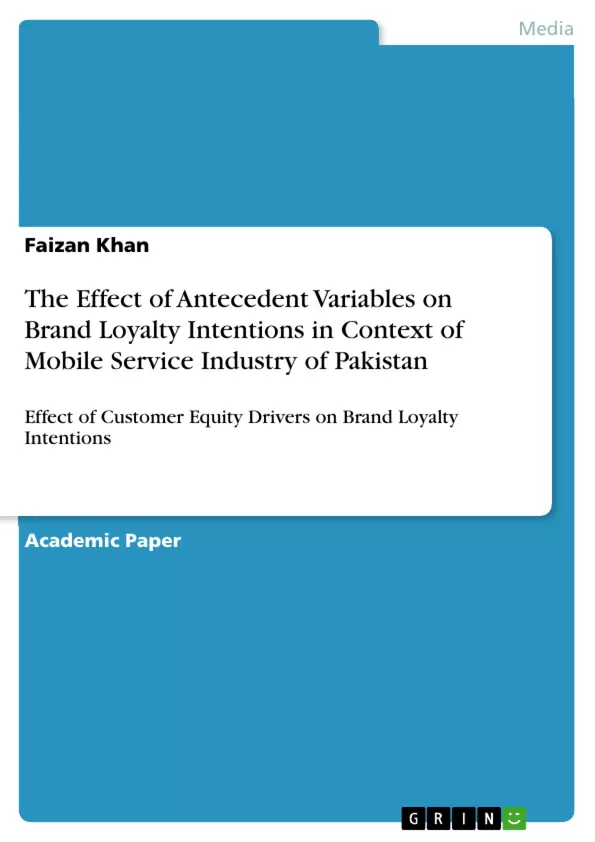Customer equity, this notion was first introduced by in which they argued that the companies and organizations should considered customers as their any other financial asset and like other financial assets they should also be measured and maximized by the management. Later came up with the study on the same topic in more deeper perspective and states the definition of customer equity by uttering that, it is life time values which are discounted of the customers who belongs directly with the company and it is an outline which represents the main business of the firm that is their key business, which separates the identity of the company from others to its customers. The customer equity drivers or retention equity drivers are consist of value, brand and relationship equity. These customers’ equity drivers be contingent upon, customer’s perception and attitude the brand. In terms of Value equity the customer’s perceptions and attitude represents the rational and unbiased situation of the service or a product, which is mainly grounded upon the perception and attitude of the customers towards price of the product or service, its quality and luxury that the customer can enjoy in the market availability of product and service. In terms of Brand equity the situation is other way around, brand equity shows the, personal as well as immaterial point of view of the customer and their attitude towards the available product and service in the market. The inner feeling and attitudes of the customer towards the company’s product or service are insubstantial, the brand equity shows the sensitive attachment of customer with the product or service and irrational situation of the market availability which associates the customer with the brand or position of the market. As discussed fact that the inner concept of customer towards brand or service, attitude and behavior are personal and insubstantial, the brand equity of the product or service inclines to illustrate the sensitive and neutral characteristics, through which customer makes his association or relationship with the brand or market, however this relationship can be influenced by the life experience of the customer and with the memories that customer have with in his mind about the brand.
Inhaltsverzeichnis (Table of Contents)
- Chapter 1.
- Introduction
- Background to the Study
- Statement of the Problem
- Objectives of the Study
- Research Question
- Significance of the Study.
- Limitations and Delimitation of the Study.
- Operational Definition of Key Terms.
- Chapter 2.
- Literature Reviews.
- Theoretical background.
- Review of Related Studies.
- Empirical Studies
- Model Hypothesis:
- Summary of the chapter
- Chapter 3.
- Methodology
- Research Approach.
- Research Purpose
- Research Design…....
- Target Population..\li>
- Sample Size
- Instrumentation:..\li>
- Control for Measurement Error.
- Content and Face Validity.
- Data Collection Technique..\li>
- Sampling Technique...\li>
- Statistical Technique.
- Unit of Analysis..\li>
- Operationalization and Measurement of Variables under Study.
- Model.
- Descriptive Variable.
- Ethical Consideration...\li>
- Chapter 4.
- Data Analysis
- Demographic Profile of Respondents..\li>
- Convergent Validity
- Discriminant Validity.
- Structural Equation Model...\li>
Zielsetzung und Themenschwerpunkte (Objectives and Key Themes)
This study aims to investigate the relationship between customer equity drivers and brand loyalty intentions. It explores the significance of value equity, brand equity, and relationship equity in influencing customer loyalty. The research seeks to provide insights into how businesses can effectively leverage customer equity drivers to achieve greater brand loyalty and competitive advantage.- The influence of customer equity drivers on brand loyalty intentions
- The role of value equity, brand equity, and relationship equity in shaping customer perceptions and behavior
- The link between brand image, perceived brand value, and brand loyalty intentions
- The development of a model to assess the impact of customer equity drivers on brand loyalty
- Practical implications for businesses seeking to enhance customer loyalty and brand equity
Zusammenfassung der Kapitel (Chapter Summaries)
- Chapter 1: Introduction This chapter provides an introduction to the research, defining customer equity and its drivers. It discusses the background of the study, stating the problem, objectives, and research question. The chapter also highlights the significance of the study, its limitations, and defines key terms, including customer equity, value equity, brand equity, and relationship equity.
- Chapter 2: Literature Reviews This chapter delves into the theoretical background of brand equity, value equity, relationship equity, perceived brand value, brand image, and brand loyalty intention. It reviews relevant studies examining the link between customer equity drivers and brand loyalty intentions. This chapter also presents the study's model hypothesis.
- Chapter 3: Methodology This chapter outlines the research methodology used in the study, including the research approach, design, target population, sample size, instrumentation, and data collection techniques. It discusses the operationalization and measurement of variables under study and the statistical techniques employed. The chapter also addresses ethical considerations.
- Chapter 4: Data Analysis This chapter presents the data analysis results, including demographic profiles of respondents, convergent validity, discriminant validity, and structural equation model analysis.
Schlüsselwörter (Keywords)
The study focuses on customer equity, brand loyalty, brand image, perceived brand value, value equity, brand equity, relationship equity, customer equity drivers, and customer retention. It explores the relationship between these concepts and investigates their impact on business success.- Citar trabajo
- Faizan Khan (Autor), 2018, The Effect of Antecedent Variables on Brand Loyalty Intentions in Context of Mobile Service Industry of Pakistan, Múnich, GRIN Verlag, https://www.grin.com/document/441969



